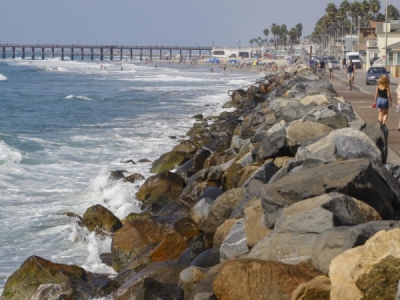
Posted on November 3, 2020
Artificial reef, bypass system, groins considered for eroding coastline
Consultants are taking a closer look at six preliminary concepts for replenishing and retaining sand on Oceanside’s eroding beaches.
“These concepts include sand-bypass systems, environmentally sensitive retention devices such as groins and artificial reefs, and the exploration of other potential long-term sand sources,” Oceanside Public Works Director Kiel Koger said by email recently.
GHD, an international consulting firm with an office in San Diego, began an engineering evaluation and feasibility study for the city in May, Koger said.
The study examines several ideas, including a 1,000-foot-long artificial reef built of rock in a shallow area of the ocean several hundred feet offshore. The reef would collect and hold sand at its edges and on the side facing the beach.
Groins are another possibility for retaining more sand. The consultants looked at some built decades ago in Newport Beach and one in Carlsbad near the Encina power plant at the outlet from the Agua Hedionda Lagoon. The study considered the possibility of a pilot project in Oceanside with two 400- to 600-foot-long rock groins, 1,500 feet apart on the city’s sand-starved southern beaches.
A third sand-retention idea examined by the consultants was a 350-foot extension of the south jetty near the Oceanside Harbor. That option appears less likely because it’s not in an area that most needs sand and it could affect a popular surfing spot.
“Nourishment,” or adding sand to the eroded beaches, is a separate concept and the consultant also studied three ways to do that.
One was a fixed bypass system that would automatically mine sand from the beach at Camp Pendleton and pump it through pipes to beaches south of the Oceanside harbor. However, that system is expensive and the city, working with the U.S. Army Corps of Engineers, tried it unsuccessfully in the early 1980s.
The study also looked at ways to build a mobile sand bypass system, which also has its drawbacks, or to continue traditional beach nourishment efforts such as pumping sand from offshore deposits, the harbor, and the San Luis Rey River.
“The city’s goal is to identify a beach replenishment/retention strategy that is environmentally sensitive, financially feasible and has a reasonable chance of being approved through the regulatory permitting process,” Koger said.
All San Diego County beaches are losing sand, and the problem is likely to increase with climate change and sea-level rise. Cities have been working with regional, state and federal agencies for decades on various projects to beef up the beaches.
The U.S. Army Corps of Engineers dredges the Oceanside harbor entrance annually and spreads the sediment on nearby beaches, but that sand rarely reaches as far as the city’s narrow and rocky shore a few blocks south of the municipal pier. Carlsbad beaches get occasional sand dredged from the Agua Hedionda and Batiquitos lagoons, and last year Solana Beach received a large deposit from the restoration of the San Elijo Lagoon.
A group of Oceanside residents called Save Oceanside Sand formed last year to advocate for the construction of as many as five rock groins, permanent structures sticking straight out from the beach to hold the sand against the prevailing ocean current. The group points to the success of the groins built in the 1960s in Newport Beach.
Oceanside depends heavily on the tourists who flock to its beaches, said SOS member Nick Ricci. Thousands of jobs, hundreds of homes and city properties all depend on an attractive coastline, so it makes sense for the city to invest in its beaches.
“We, SOS, have from the beginning been strong advocates for groins,” Ricci said. “So, seeing groins as one of the possible solutions for our difficulties is affirming. Of course, the science to endorse which possible solution is best will determine which solution will be favored.”
It’s also encouraging for the group to see sand replenishment included in the report, he said.
Anything built on the beach would have to be approved by the California Coastal Commission, which oversees all coastal development.
The goal of the city’s project is to develop a program that is financially feasible, environmentally sensitive, and that will be approved by the Coastal Commission and other agencies.
Source: sandiegouniontribune





